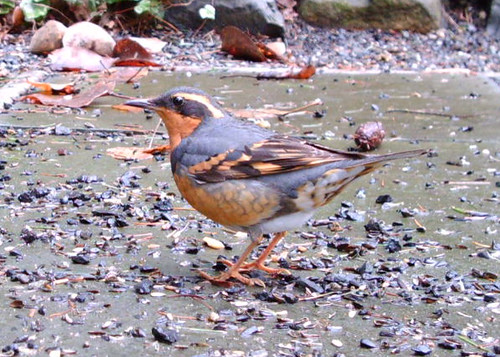Tapping away on the laptop late this morning, I noticed out of the corner of my eye considerable activity just outside the window in our yard. The flashes of orange and black, and the overall level of commotion made me initially think it was simple a flock of passing American Robins, Turdus migratorious, and I kept working without turning to observe the situation more closely. However in the midst of a spine-correcting stretch necessitated by too long sitting in the same position, I gained a more complete view of the yard and discovered to my surprise that the flock previously but inattentively noticed was of a different thrush entirely – Varied Thrush, Ixoreus naevius, to be precise.

This past winter has indeed been a prolific one for Varied Thrush activity around our home. Nestled as we are against a coniferous forest in the Pacific Northwest, the Varied Thrush has been one of our more frequently seen feeder birds this past season. However whenever they are seen, it has been in small numbers, seldom more than two at any one time. Yet this morning I beheld no fewer than eight in our yard alone, and five of six more in the yard of our neighbor.
I had just remarked to my wife earlier the same morning having looked out the kitchen window and seen a Varied Thrush beneath one of the back feeders that I was surprised to still be seeing this species now that April had arrived. Previous years have known them to have moved deeper into the forest to nest or to possibly have migrated further north into Washington, British Columbia, or Alaska (we seem to have quite a few species here in northwest Oregon that employ “leap frog” migrations – southern more wintering birds travelling further north than our local populations).
Perhaps that was what this flock in our front yard represented – a migrating flock headed further north. It certainly more than represented the total number I would have expected to be in the immediate area given the level of visibility they had shown throughout the winter. Of course, there is also the possibility that the bright and clear early April day, as it likely did for many local human residents of the area, simply put them all in the mood to gather together in the sun for a bit of socializing and outdoor dining. Whatever their reason, it was indeed good to see them, especially knowing that before long they will be absent from our property until late into next autumn.
Peace and good bird watching.
